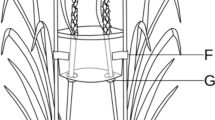Abstract
Female cowpea weevils,Callosobruchus maculatus, produce a sex pheromone that elicits orientation and sexual behavior in males. Bioassay-directed isolation of the sex pheromone was conducted and compounds in the active fraction were identified and synthesized. Volatiles were collected from individual virgin females by adsorption on filter paper dises and hexane extraction. A bioassay was used in which the locomotory response of single males in glass vials was recorded upon exposure to treatments or controls. Crude extracts were subjected to silica gel column chromatography with solvents of increasing polarity; all activity eluted with methanol. Activity in the highly polar methanol fraction suggested a carboxylic acid or a compound with multiple polar functionality. Acid-base partitioning of the crude extract isolated all activity in the acid fraction, confirming that the pheromone was a carboxylic acid. The acid fraction was further fractionated by preparative GC with a Carbowax column. The most active GC fraction contained the following five 8-carbon acids identified by GC-MS and comparison with synthetic candidates: 3-methyleneheptanoic acid, (Z)-3-methyl-3-heptenoic acid, (E)-3-methyl-3-heptenoic acid, (Z)-3-methyl-2-heptenoic acid, and (E)-3-methyl-2-heptenoic acid. Each of the synthetic acids was active individually for males, and combinations of two or more of the acid pheromones had an additive effect. Upwind flight responses to natural and synthetic pheromones were observed in a flight tunnel. (Z)-3-Methyl-2-heptenoic acid was previously identified as the sex pheromone for the relatedC. analis, but this and the other four acid pheromones fromC. maculatus were inactive for maleC. analis. There was no cross-attraction betweenC. maculatus andC. analis in reciprocal studies using extracted volatiles from females of both species, GC-MS analysis ofC. analis female volatiles failed to detect any of theC. maculatus compounds but did find an unidentified C-8 acid with a GC retention time different from any of theC. maculatus pheromones.
Similar content being viewed by others
References
Bartelt, R. J., Dowd, P. F., Plattner, R. D., andWeisleder, D. 1990. Aggregation pheromone of driedfruit beetle.Carpophilus hemipterus: Wind-tunnel bioassay and identification of two novel tetraene hydrocarbons.J. Chem. Ecol. 16:1015–1039.
Brownlee, R. G., andSilverstein, R. M. 1968. A micro-preparative gas chromatograph and a modified carbon skeleton determinator.Anal. Chem. 40:2077–2080.
Burkholder, W. E., andMa, M. 1985. Pheromones for monitoring and control of stored-product insects.Annu. Rev. Entomol. 30:257–272.
Byrne, K. J., Gore, W. E., Pearce, G. T., andSilverstein, R. M. 1975. Porapak-Q collection of airborne organic compounds serving as models for insect pheromones.J. Chem. Ecol. 1:1–7.
Camps, F., Coll, J., andGuitart, J. 1987. Reduction of alkyl 2,4-alkadienoates with sodium dithionate under phase transfer conditions.Tetrahedron 10:2329–2334.
Cork, A., Hall, D. R., Blaney, W. M., andSimmonds, M. S. J. 1991. Identification of a component of the female sex pheromone ofCallosobruchus analis (Coleoptera: Bruchidae).Tetrahedron Lett. 32:129–132.
Fujisawa, T. F., Sata, T., Gotoh, Y., Kawashima, M., andKawara, T. 1982. Reaction of diketene with Gringard reagents in the presence of cobalt catalyst. A convenient method for the synthesis of 3-methylene-alkanoic acids leading to terpenoids.Bull. Chem. Soc. Jpn. 55:3555–3559.
Halstead, D. G. H. 1973. Preliminary biological studies on the pheromone produced byAcanthoscelides obtectus (Say).J. Stored Prod. Res. 9:109–117.
Hauser, C. R., andBreslow, D. S. 1955. Ethyl-β-phenyl-β-hydroxypropionate. pp. 408–410,in E. C. Horning (ed.). Organic Syntheses Collected Volume III. John Wiley and Sons, New York.
Horler, D. F. 1970. (−)-Methyl-n-tetradeca-trans-2,4,5-trienoate, and allenic ester produced by the male dried bean beetle,Acanthoscelides obtectus (Say).J. Chem. Soc. C 1970: 859–862.
Phillips, T. W. 1997. Semiochemicals of stored-product insects: research and applications.J. Stored Prod. Res. 33: In press.
Qi, Y. T., andBurkholder, W. E. 1982. Sex pheromone biology and behavior of the cowpea weevilCallosobruchus maculatus (Coleoptera: Bruchidae).J. Chem. Ecol. 8:527–534.
Rup, P. J., andS. P. Sharma. 1978. Behavioural responses of males and females ofCallosobruchus maculatus (F.) to the sex pheromones.Indian J. Ecol. 5:72–76.
SAS Institute. 1989. SAS User's Guide: Statistics. SAS Institute, Cary, North Carolina.
Silverstein, R. M., Bassler, G. C., andMorill, T. C. 1991. Spectrometric Identification of Organic Compounds, 5th ed. John Wiley & Sons, New York.
Tanaka, K., Ohsawa, K., Honda, H., andYamamoto, I. 1981. Copulation release pheromone, erectin, for the Azuki bean weevil (Callosobruchus chinensis L.).J. Pestis. Sci. 6:75–82.
Yamamoto, I. 1990. Chemical ecology of bruchids, pp. 53–62,in K. Fujii et al. (eds.). Bruchids and Legumes: Economics, Ecology and Coevolution. Kluwer Academic, Dordrecht, The Netherlands.
Author information
Authors and Affiliations
Additional information
This article reports the results of research only. Mention of a proprietary product does not constitute an endorsement or a recommendation for its use by USDA.
Rights and permissions
About this article
Cite this article
Phillips, T.W., Phillips, J.K., Webster, F.X. et al. Identification of sex pheromones from cowpea weevil,Callosobruchus maculatus, and related studies withC. analis (coleoptera: Bruchidae). J Chem Ecol 22, 2233–2249 (1996). https://doi.org/10.1007/BF02029543
Received:
Accepted:
Issue Date:
DOI: https://doi.org/10.1007/BF02029543




